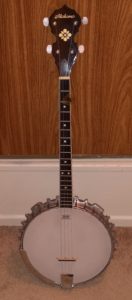
At my last show, I had a few people asking about the banjo I play. When most think of the banjo, they think of the five-string variation – and of bluegrass picking. My banjo has four strings and an odd metal body (most are wood), so I often refer to it as my “steampunk Irish banjo”.
Let’s get you there with a little history.
The banjo started out as a fretless instrument with a skin stretched over a gourd. It’s earliest origins are traced back to Africa, with the one short string where the bass string is on most stringed instruments. That short, higher-toned string was often used as a drone, giving the banjo – and the music played on it – a unique sound.
When Africans were kidnapped from their homes to be enslaved in North America, the banjo also made the journey, and eventually made its way to the Appalachian mountains, where it was adopted as an instrument of choice for old-time music.
In the late 1800s, the banjo actually became a “parlour” instrument for young, rich women to play classical music, in hopes of attracting a rich husband, if you can imagine such a thing.
Earl Scruggs popularized the five-string banjo – now a fretted instrument – in the earliest forms of bluegrass music, by developing a fast finger-picking method that build on some of those old-time playing styles. This is the banjo style we’re most accustomed to, but is actually the newest style.
Decades before that, as jazz was becoming popular, guitarists hadn’t invented electricity yet, so they were regularly getting drowned out by horns. Banjos – with their brasher tone and volume were seen as the answer, but that drone string was getting in the way for people who wanted to strum with a pick instead of using their fingers.
When a lot of jazz players started doing this, the manufacturers took notice, and began making four-string banjos in a few variations: the plectrum banjo (tuned similar to a five-string), the tenor banjo (tuned like a viola), the banjo uke (tuned like a ukulele), and then the eight-stringed banjolin (basically a mandolin with banjo body).
As the tenor banjo gained popularity here, there were lute players in Ireland with similar problems: They were trying to pick the melodies for jigs and reels, but were often drowned out by accordions. Using the tenor banjo with an alternate tuning (same as the mandolin, but an octave lower) combatted the plague of accordions.
Flash forward to 2013 when a ruggedly handsome mandolin player was trying to sing and play folk songs. I was wanting to gig, but was afraid that people would get tired of the high treble on the mandolin for a full set. My brother told me about Irish tuning on the tenor banjo, so I simply had to have one.
I ordered the cheapest tenor banjo I could find, and set it up with Irish tuning. I found the volume a bit much for jamming, so I removed the wooden resonator from the back, leaving this metal beast that’s shaped like a huge cog stolen from some old industrial machinery. The resulting sound growls with just the intensity I didn’t realize I was looking for.
Which of those various historical styles do I play? So far as I know, I don’t really play it like any of them. I think I mostly play like a guitarist who has taught himself mandolin and tenor banjo. Since I’m a solo performer, I use a pick, and I end up mixing chords, melody, and percussion on my banjo to try to vary the accompaniment to my voice.
So endeth the lesson.
